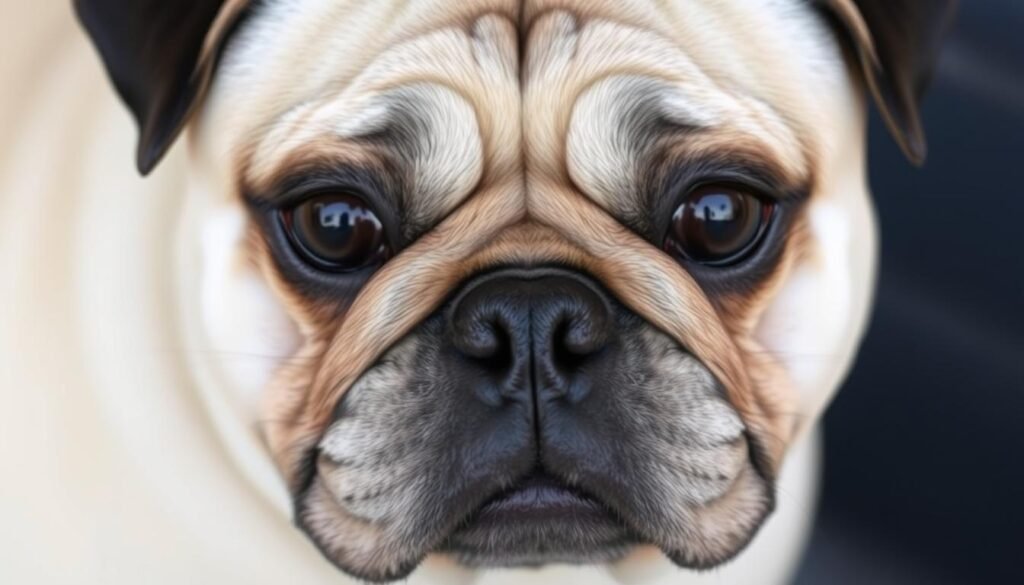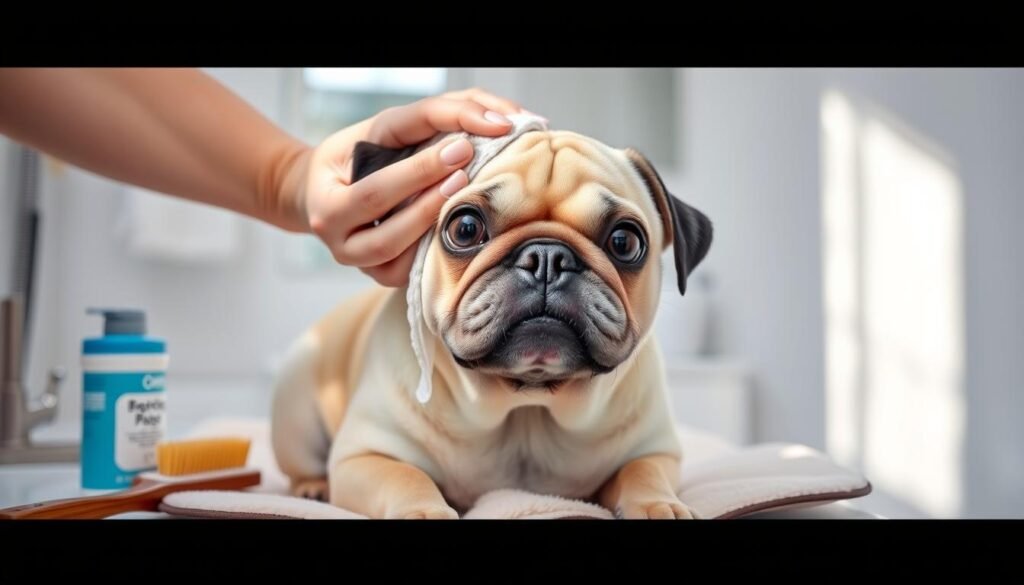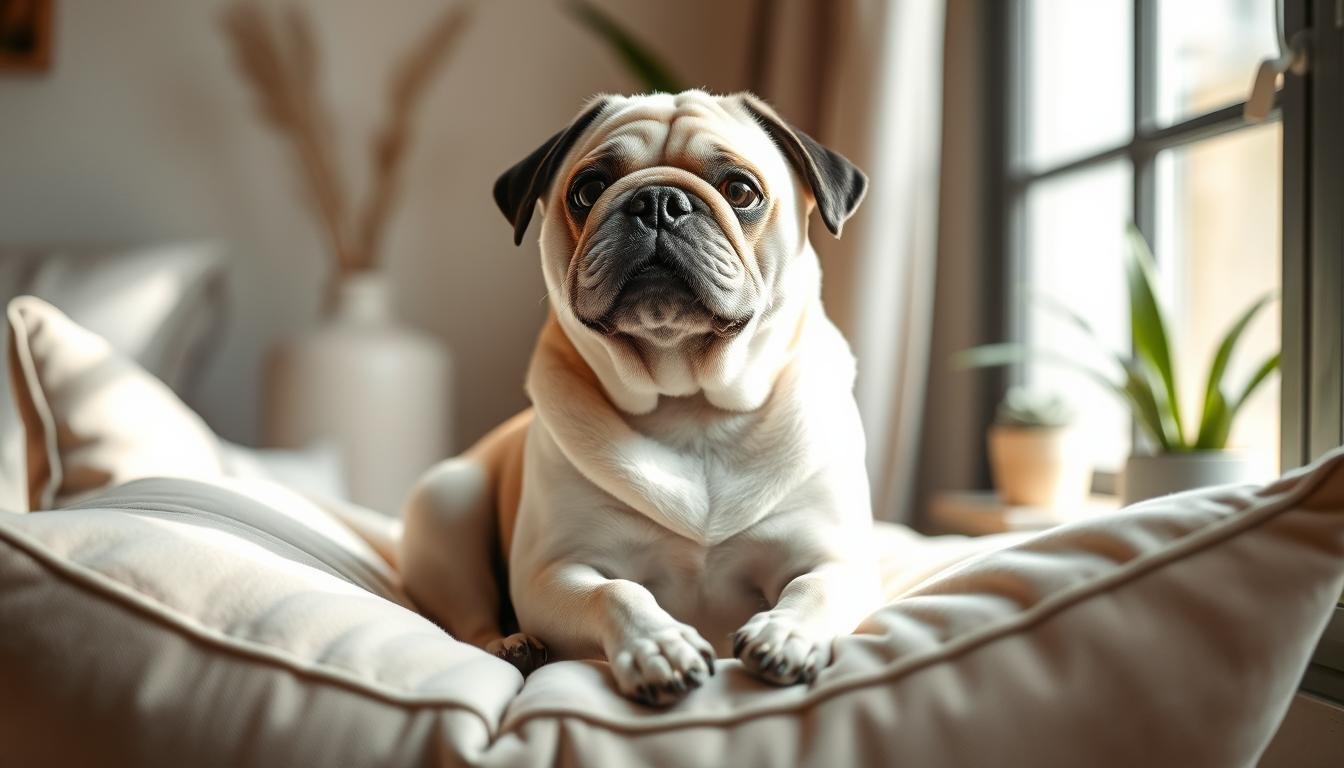How to avoid eye stains in light-colored Pugs
Up to 80% of light-colored Pugs can get unsightly reddish-brown tear stains around their eyes. These stains not only ruin your pet’s look but can also hint at health issues if ignored. This guide will show you how to prevent and manage these stains in your light-colored Pug.
You’ll learn about the causes and how to keep your Pug’s face clean and tear-free. Whether your Pug has allergies, a special face shape, or just needs extra care, we’ve got you covered.
Understanding the Causes of Tear Stains in Pugs

Tear stains in Pugs can be a common and frustrating issue. But knowing the causes can help pet owners tackle the problem. Pugs, like other brachycephalic breeds, have unique eye shapes and facial structures. These features contribute to tear stains.
Eye Shape and Facial Structure
Pugs have shallow eye sockets and skin folds around their eyes. These can trap debris and moisture, causing irritation and excessive tearing. Their anatomy makes them more prone to tear staining than other breeds.
Allergies and Health Issues
Allergies and health issues also play a part in tear staining. Pugs can have environmental allergies or food allergies. These can irritate their eyes and cause tearing. Blocked tear ducts or infections can make stains worse, leading to reddish-brown stains on their face.
It’s important to understand the factors behind tear stains in Pugs. This includes their eye shape, facial structure, and health concerns. Knowing this helps in creating a good prevention and management plan.
“Tear stains in Pugs are a common issue, but with the right approach, pet owners can help minimize their appearance and keep their Pug’s face clean and healthy.”
Maintaining a Clean and Dry Face

Keeping your Pug’s face clean and dry is key to avoiding and managing tear stains. Set up a regular Pug grooming tips and cleaning schedule. This helps your pet look great. It includes flushing eyes with saline, using Pug tear stain remedies, and trimming eye hair.
Grooming and Cleaning Routines
First, make sure your Pug’s water is pure or distilled. This stops mineral and chemical irritants that cause Pug tear stains. Use a bowl with a narrow rim to cut down on moisture around the muzzle. Regular grooming is important, especially around the facial hair care for Pugs.
Trim the hair around the eyes and nose to stop debris buildup. This keeps your Pug’s face clean.
Try dietary supplements or products made to reduce porphyrin and lighten Pug tear stains. But talk to your vet before adding anything new to your Pug’s routine.
“Maintaining a clean and dry face is essential for managing tear stains in Pugs. With a consistent grooming routine and the right products, you can keep your Pug looking their best.”
How to avoid eye stains in light-colored Pugs

Keeping your light-colored Pug’s face clean is key. Start by grooming and caring for them regularly. Use a gentle, pH-balanced solution to clean around their eyes. This helps remove moisture and debris that can cause stains.
Trimming the hair around their eyes also helps. It improves airflow and stops fur from getting stained. This keeps your Pug’s face looking great and prevents eye stains.
- Use a gentle, pH-balanced solution to clean the area around your Pug’s eyes
- Trim the hair around the eyes to improve airflow and reduce stain buildup
- Ensure your Pug has access to clean, filtered water and a high-quality diet free from potential allergens
Creating a healthy environment for your Pug is also important. Make sure they have clean water and a good diet. These steps help keep your Pug’s face clean and prevent eye stains.
“With patience and a consistent routine, you can keep your Pug’s face looking its best.”
When to Seek Veterinary Assistance

Dealing with tear stains on your Pug can be a challenge. Knowing when to see a vet is key. Many tear stains can be managed with good grooming and home care. But, some cases need medical help.
If your Pug’s tear stains come on suddenly or with other symptoms, see your vet. Symptoms like swollen eyes, yellow or bloody discharge, or changes in behavior are red flags. Your vet can check for health issues like blocked tear ducts, infections, or allergies.
Your vet might give eye drops or ointments to treat the cause of the stains. This is especially useful for Pugs with light coats, as stains show up more.
“Proper veterinary care is essential when addressing persistent or concerning tear stains in Pugs, as it can help prevent further complications and ensure the long-term health and well-being of your beloved companion.”
While home remedies or over-the-counter products might seem appealing, always talk to a vet first. They can guide you to the safest and most effective treatment. With their help, you can keep your Pug’s tear stains under control and ensure their health and happiness.
Removing Existing Tear Stains
If your light-colored Pug has tear stains, there are ways to remove them. You can use a diluted hydrogen peroxide solution or dog tear stain wipes. These can help lighten the stains. Also, trimming the hair around the eyes can help keep the area clean.
In some cases, your vet might suggest products with boric acid or chlorhexidine. These can help get rid of tear staining. With regular care, your Pug’s face can look bright and clean again.
To lighten Pug tear stains, you can try a baking soda and water paste. Or, use white vinegar or coconut oil on the stains. Always talk to a groomer or vet for the safest way to clean Pug face and eyes and remove existing tear stains.

